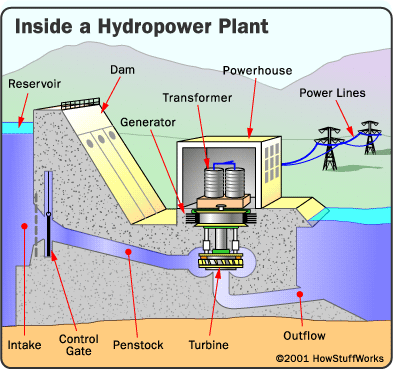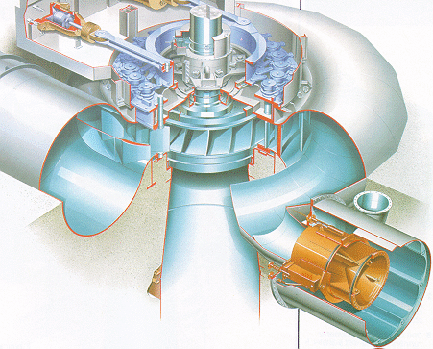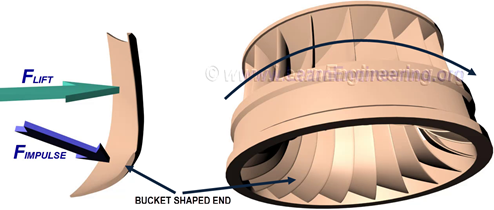The
Workings of a Water Turbine
Currently we are still using the basic desgins from
Francis and other past scientists. Over the last few
decades hydroelectric power stations have not been built.
This is because in the lower 48s the best and
largest locations have already been tapped into. It is
estimated that 75 percent of the potential water power of
the U.S. is already being used up. Alaska though is quite
different. less than 1 percent of the estimated 167
million kilowatts available in Alaska has been harnessed
to date[7].
How Water Turbines Work
Water turbines rely on simple principles of
physics. The turbines use waters high flowing energy to
turn a blade that is connected to the shaft of a generator
to generate electricity. The figure above gives a basic
understanding of the parts of a hydropower plant.

Courtesy of
http://science.howstuffworks.com/environmental/energy/hydropower-plant1.htm
Dam- This part of the hydroplant holds back the
reservoir and contains massive amounts of potential
energy.
Intake- Hydrostatic pressure pulls the water through the penstock. The penstock is a pipeline that leads to the turbine. A penstock is what controls the rate and volume of water flow from a water source towards a hydro turbine generator. It is usually designed as a closed pipe with opening and closing gates to allow only the desired amount of water into the system[5].
Turbine- The water rushes in and strikes the large
blade of the turbine which is attached to a generator
above by a shaft. The most common type of turbine for
hydoplants is a Francis turbine. These turbines can weigh
as much as 172 tons and turn at a rate of 90 revolutions
per minute. Francis turbines are most used because
they are able to operate efficiently even  with large changes in flow rates.
The blades of the Francis turbine are shaped precisely to provide lift.
When water flows over the blades, a low pressure will be
induced on one side, and high pressure on the other side. This
will result in a lift force. The blades also get another
help with rotation, and that is the impulsive force due to
the bucket shape towards the outlet. As you can see Newton’s
third law is being used extensively here. A spiral casing
is used on the Francis turbines to maximize flow energy.
When power needs vary the Francis turbines are equipped
with guide vanes to control flow rates and flow angle[5][6].
with large changes in flow rates.
The blades of the Francis turbine are shaped precisely to provide lift.
When water flows over the blades, a low pressure will be
induced on one side, and high pressure on the other side. This
will result in a lift force. The blades also get another
help with rotation, and that is the impulsive force due to
the bucket shape towards the outlet. As you can see Newton’s
third law is being used extensively here. A spiral casing
is used on the Francis turbines to maximize flow energy.
When power needs vary the Francis turbines are equipped
with guide vanes to control flow rates and flow angle[5][6].

Image courtesy of http://www.learnengineering.org/2014/01/how-does-francis-turbine-work.html
Here is a link to a good video on Francis Turbines:
http://www.youtube.com/watch?v=3BCiFeykRzo
Generator- As you should know from class, their are a series of magnets are turning inside the generator as the turbine blades turn. These giant magnets rotate past the copper coils to produce alternating current.
Transformers- Inside the power plant is a
transformer that steps up the voltage. Stepping up this
generated voltage depends on the number of turns on the
secondary coil. A step-up transformer can raise the
voltage by several hundred thousands volts.
 ,
,
Image courtesy of www.mekanizmalar.com
Important Factors for Hydro-Power
Now that you have learned the many parts a hydoplant, lets look at some key factors to maximize power generation.
Power = Gravity*Water Flow Rate*Head
Height
We are familiar with gravity of course,but not flow
rate and head height. The hydraulic head is the
distance that water flows from the higher elevation where
it is stored, to the hydro-turbine
generator. Hydraulic head is usually divided into three
categories: low, medium, and high head.
Elevations above around 100 meters are usually
considered high head, while low head system elevations
range around 10 meters in height. A high head hydro
turbine system requires less volume of water flow to
operate because the momentum collected from gravity
through the longer distance of falling water makes up for
the loss of volume.
The high head systems also require a smaller turbine
because of the lower volume of water flow needed.
A low head hydro turbine is usually used in a
flowing river with little elevation change, or in moving
ocean tides.
A low head system with a high volume of water usually
requires a much larger turbine generator to efficiently
convert the water energy into electricity[8].
Environmental Impacts
Although hydroelectric power is much cleaner compared to fossil fuel, it still poses risks to the environment. A dam can seriously alter the ecosystem near it. Dams have been known to help kill off fish species, because it is very difficult for them to migrate upstream even with a fish ladder installed. When the height of the water reservoir changes, it impacts the plants and animals that depend on that water[8].